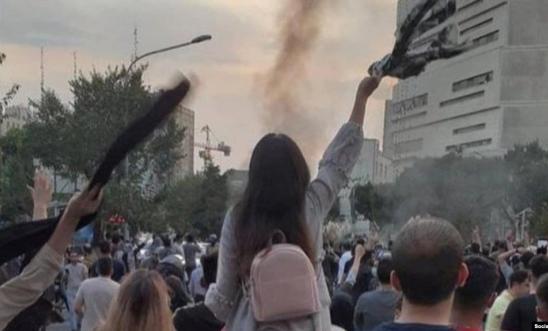
Press releases
Iran: Leaked documents reveal highest military body ordered troops to crush protests at any cost

Documents obtained by Amnesty reveal authorities were instructed to “severely confront” protesters at any cost
52 people killed and hundreds injured in brutal crackdown to date
‘The Iranian authorities knowingly decided to harm or kill people who took to the streets to express their anger at decades of repression and injustice’ - Agnes Callamard
Iran’s highest military body instructed the commanders of armed forces in all provinces to “severely confront” protesters who took to the streets following the recent death in custody of Mahsa Amini at the hands of Iran’s morality police, Amnesty International said today after obtaining leaked official documents, which revealed the authorities’ plan to systematically crush the protests at any cost.
The crackdown has left at least 52 identified victims dead and hundreds injured to date.
In a detailed analysis issued today, Amnesty reveals evidence of the Iranian authorities’ plot to brutally crush the demonstrations by deploying the Revolutionary Guards, the Basij paramilitary force, the Law Enforcement Command of the Islamic Republic of Iran, riot police, and plainclothes security agents.
Amnesty also shared evidence of the widespread use of lethal force and firearms by Iranian security forces who either intended to kill protesters or should have known with a reasonable degree of certainty that their use of firearms would result in deaths.
Agnes Callamard, Amnesty International’s Secretary General, said:
“The Iranian authorities knowingly decided to harm or kill people who took to the streets to express their anger at decades of repression and injustice. Amid an epidemic of systemic impunity that has long prevailed in Iran, dozens of men, women and children have been unlawfully killed in the latest round of bloodshed.
“Without determined collective action by the international community, which needs to go beyond mere statements of condemnation, countless more face being killed, maimed, tortured, sexually assaulted or thrown behind bars solely for their participation in protests.
“These leaked documents obtained by Amnesty bring into sharp focus the need for an international independent investigative and accountability mechanism.”
Based on eyewitness accounts and audio-visual evidence reviewed by Amnesty, none of the victims posed any imminent threat of death or serious injury that could warrant the use of firearms against them.
State denial and coverup
One of the documents is a leaked copy of an official document stating that on 21 September, the General Headquarters of Armed Forces issued an order to commanders in all provinces instructing them to “severely confront troublemakers and anti-revolutionaries”. Later that evening, the use of lethal force across the country escalated with dozens of men, women and children killed that night alone.
Another leaked document shows that on 23 September, the commander of the armed forces in Mazandaran province ordered security forces in all towns and cities in the province to “confront mercilessly, going as far as causing deaths, any unrest by rioters and anti-Revolutionaries”.
Victims of violence
Amnesty has so far recorded the names of 52 people - including five women and at least five children - killed by Iran’s security forces between 19 September and 25 September. At least 34 were killed on 21 September. Amnesty believes the real death toll is far higher and is continuing its efforts to identify victims.
Amnesty has reviewed photos and videos showing that most victims were killed by security forces firing live ammunition. At least three men and two women were killed due to security forces firing metal pellets at close range, while a 16-year-old girl, Sarina Esmailzadeh, died after being severely beaten in the head with batons.
In an attempt to absolve themselves of responsibility for the deaths, the Iranian authorities have shared false narratives about victims, attempting to portray them as “dangerous”, “violent individuals” or claiming that they had been killed by “rioters”.
The authorities have been also intimidating and harassing victims’ families into silence or promising them financial compensation if they recorded videos attributing responsibility of their loved ones’ deaths to “rioters” working for “enemies” of the Islamic Republic of Iran.
Protesters tortured
Amnesty has documented widespread patterns of torture and other violence by security forces, including severe beatings of protesters and bystanders, sexual assault and other forms of gender-based and sexual violence, including cases where security forces grabbed women’s breasts or violently pulled their hair after they removed their headscarves in protest.
On 28 September, a protester from Esfahan told Amnesty:
“I have seen protesters beaten. The night before, my friends recounted how they saw one woman [protester] was yanked from her hair along the ground. Her clothes were coming off her body and the security forces kept pulling her by the hair…
“Two nights ago, several of my friends were beaten with batons. One of them, who has now got bruises on her forearm and legs, told me that security forces cornered them in an alley and beat them with batons. One member of the security forces then said, ‘let’s also shoot them in the leg’ and another security agent said, ‘no, let’s go’. They are so brutal.”
Amnesty has seen footage and reports suggesting that some protesters have engaged in acts of violence. However, Amnesty stresses that violent acts by a minority of protesters do not justify the use of lethal force.
According to international human rights law and standards, even if some protesters engage in violence, law enforcement officials must ensure that those who remain peaceful can continue protesting without facing undue interference or intimidation by security forces. Any force used in response to such violence must at all times comply with the principles of legality, necessity and proportionality in accordance with international law.
Security forces must not use firearms except to defend themselves or others against an imminent threat of death or serious injury, and only when less extreme and harmful means are insufficient to protect life.